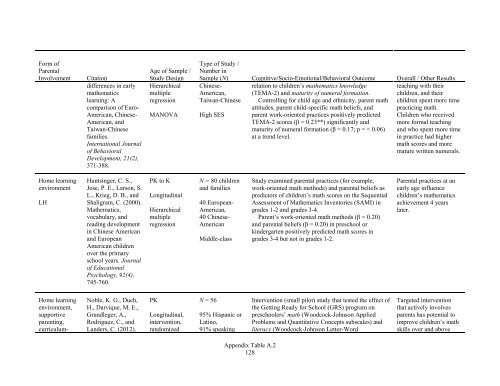u3QtN
u3QtN
u3QtN
Create successful ePaper yourself
Turn your PDF publications into a flip-book with our unique Google optimized e-Paper software.
Form of<br />
Parental<br />
Involvement<br />
Citation<br />
differences in early<br />
mathematics<br />
learning: A<br />
comparison of Euro-<br />
American, Chinese-<br />
American, and<br />
Taiwan-Chinese<br />
families.<br />
International Journal<br />
of Behavioral<br />
Development, 21(2),<br />
371-388.<br />
Age of Sample /<br />
Study Design<br />
Hierarchical<br />
multiple<br />
regression<br />
MANOVA<br />
Type of Study /<br />
Number in<br />
Sample (N) Cognitive/Socio-Emotional/Behavioral Outcome Overall / Other Results<br />
Chinese-<br />
American,<br />
Taiwan-Chinese<br />
High SES<br />
relation to children’s mathematics knowledge<br />
(TEMA-2) and maturity of numeral formation.<br />
Controlling for child age and ethnicity, parent math<br />
attitudes, parent child-specific math beliefs, and<br />
parent work-oriented practices positively predicted<br />
TEMA-2 scores (β = 0.23**) significantly and<br />
maturity of numeral formation (β = 0.17; p = < 0.06)<br />
at a trend level.<br />
teaching with their<br />
children, and their<br />
children spent more time<br />
practicing math.<br />
Children who received<br />
more formal teaching<br />
and who spent more time<br />
in practice had higher<br />
math scores and more<br />
mature written numerals.<br />
Home learning<br />
environment<br />
LH<br />
Huntsinger, C. S.,<br />
Jose, P. E., Larson, S.<br />
L., Krieg, D. B., and<br />
Shaligram, C. (2000).<br />
Mathematics,<br />
vocabulary, and<br />
reading development<br />
in Chinese American<br />
and European<br />
American children<br />
over the primary<br />
school years. Journal<br />
of Educational<br />
Psychology, 92(4),<br />
745-760.<br />
PK to K<br />
Longitudinal<br />
Hierarchical<br />
multiple<br />
regression<br />
N = 80 children<br />
and families<br />
40 European-<br />
American,<br />
40 Chinese-<br />
American<br />
Middle-class<br />
Study examined parental practices (for example,<br />
work-oriented math methods) and parental beliefs as<br />
predictors of children’s math scores on the Sequential<br />
Assessment of Mathematics Inventories (SAMI) in<br />
grades 1-2 and grades 3-4.<br />
Parent’s work-oriented math methods (β = 0.20)<br />
and parental beliefs (β = 0.20) in preschool or<br />
kindergarten positively predicted math scores in<br />
grades 3-4 but not in grades 1-2.<br />
Parental practices at an<br />
early age influence<br />
children’s mathematics<br />
achievement 4 years<br />
later.<br />
Home learning<br />
environment,<br />
supportive<br />
parenting,<br />
curriculum-<br />
Noble, K. G., Duch,<br />
H., Darvique, M. E.,<br />
Grundleger, A.,<br />
Rodriguez, C., and<br />
Landers, C. (2012).<br />
PK<br />
Longitudinal,<br />
intervention,<br />
randomized<br />
N = 56<br />
95% Hispanic or<br />
Latino,<br />
91% speaking<br />
Intervention (small pilot) study that tested the effect of<br />
the Getting Ready for School (GRS) program on<br />
preschoolers’ math (Woodcock-Johnson Applied<br />
Problems and Quantitative Concepts subscales) and<br />
literacy (Woodcock-Johnson Letter-Word<br />
Targeted intervention<br />
that actively involves<br />
parents has potential to<br />
improve children’s math<br />
skills over and above<br />
Appendix Table A.2<br />
128


